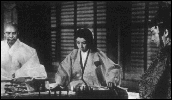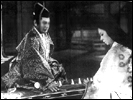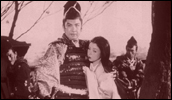Gate of Hell
- Year
- 1953
- Original title
- Jigokumon
- Japanese title
- 地獄門
- Director
- Cast
- Running time
- 89 minutes
- Published
- 7 March 2002



by Jasper Sharp
In 1928, intrepid 32-year-old Teinosuke Kinugasa embarked on the long voyage across Asia with a print of his second self-financed feature, Crossroads (Jujiro) under his arm. After touching base with Eisenstein and Pudovkin in Moscow, he made his way to Berlin where he was able to sell the film to a German distributor. Thus the German Expressionist-influenced period piece Crossroads became the first Japanese film to be seen in Europe by quite a long margin, and went on to play in Paris, London, and New York (under the title The Slums of Yoshiwara).
Kinugasa returned to Japan where, in keeping with the rising nationalistic tide of the pre-War period, his work became less experimental and less obviously influenced by outside sources, as he involved himself with the more commercially safe traditional jidai-geki period dramas. Twenty-five years and literally dozens of films later, Kinugasa's name was on the lips of everyone outside Japan once more, when Gate of Hell was picked out for the Grand Prix at the 1954 Cannes Film Festival and in the same year became the first recipient of the Oscar for the new Best Foreign Film category.
During the early 1950s the rest of the world was only just beginning to awaken to the power and beauty of films made in Japan, with such titles as Akira Kurosawa's Rashomon (1950), Kimisaburo Yoshimura's The Tale of Genji (Genji Monogatari, 1952), Kenji Mizoguchi's Ugetsu (Ugetsu Monogatari, 1953), and Kinugasa's film spearheading what is often termed The Golden Age of Japanese Cinema. The film's producer, Daiei's Masaichi Nagata, invested a lot pushing Gate of Hell into foreign competition, realising that a success abroad like Rashomon equated to big bucks at the box office for the company.
Adapted from a play by the twentieth century writer Kan Kikuchi, based on a story from the Heian period (794-1185) - the same era in which Rashomon and The Tale of Genji are set - Kinugasa's film opens in the midst of the spectacular battle of the Heiji War. The year is 1159, and a revolt against the emperor Goshirakawa begins with an attack on the Imperial Palace of Sanjo by the rival Minamoto clan. In order to protect the emperor and his younger sister princess Josaimon-In, decoys are sent from the palace in the form of Morito (Hasegawa), a warrior of the imperial palace, and Kesa (Kyo), a lady in waiting to the princes. The two escape to the deserted house of Morito's older brother, only to discover that his sibling has joined with the rebels. During the resulting mêlée, Kesa makes her escape. However, the insurgency is quickly quashed, and the heads of the decapitated traitors hung from the Gate of Hell at the palace entrance.
The revolt now over, the Emperor's regent Kiyamori (Sendo) grants Morito any wish he desires in reward for his bravery, despite the shameful antics of his treacherous brother. Morito, having fallen head over heals with Kesa during their flight together asks for her hand, yet his request proves impossible: Kesa is already married to Wataru (Yamagata), another of the emperor's favoured warriors. However, the insanely proud Morito refuses to take no for an answer. If he can't win her by honourable conduct on the battlefield, he'll have to take her by force, even if it leads to murder.
Gate of Hell was Daiei's first colour production, filmed using imported Eastman colour stock (Shochiku had pipped Daiei to the post for the title of the first colour feature to be made in Japan, with Keisuke Kinoshita's Carmen Comes Home, a comic melodrama filmed in Fujicolor two years previously). Western critics at the time took note of the delicately beautiful cinematography of Kinugasa's regular cameraman Kohei Sugiyama, with whom he'd worked since his early foray into filmic avant-garde, A Page of Madness (and who'd also shot Ugetsu Monogatari and A Tale of Genji, which had won him Cannes's Best Photography prize in 1952), as well as the intricately detailed set design of Kisaku Ito and sumptuously patterned fabrics of costume designer Sanzo Wada (who also picked up an Oscar for his troubles). Still today the film looks as stunning as ever, with its opening battle scenes partially shrouded behind billowing veils and banners, and the majestic flight of the troops from the burning imperial palace providing some of the most remarkable images, as well such memorable set pieces as a horse race and Morito's tense night time confrontation with Wataru and Kesa at the film's climax.
Kazuo Hasegawa hits the perfect note as the vaguely ridiculous Morito, shamed by his brother and thwarted by circumstance in his love for Kesa, yet proud and valiant on the battlefield. A long-standing associate of Kinugasa's, the former onnagata actor worked with the director for most of their working lives, though is most famous for his role in Kon Ichikawa's An Actor's Revenge, itself the remake of an earlier Kinugasa film. When both the actor and director left Shochiku for Toho, Hasegawa left under a dark cloud, and was forced to leave his early stage name of Chojiro Hayashi behind him for contractual reasons. One evening in late 1937, Hasegawa was attacked by a razor-wielding thug, established to be a professional hood hired by Shochiku - the scars on his right cheek can still be seen in this film, despite subsequent intensive surgery. Machiko Kyo, the best-known Japanese actress of the time in the West thanks to her starring roles in most of the aforementioned highpoints of the Golden Age, plays Kesa with the exaggerated demureness that goes hand in hand with Japanese ideals of femininity, looking divine in a kimono as, head bowed in deference, she tends to Wataru's every need.
Indeed, it must have been these cosmetic elements that led to the film's positive reception at Cannes, because ultimately they are its strongest elements. Gate of Hell looks undeniably stunning, but the story lags considerably at points, and with so many characters referred to in the third person during its early stages, rather confusing to boot. If the director cited the reasons for Crossroads's greater commercial success in Europe than in his own country as being down to its "Orientalist" curiosity value, he must have been equally perplexed by the prizes heaped upon Gate of Hell, as it made none of the critics's top ten lists back home. Kinugasa himself was fully aware of his picture's dramatic weaknesses, and blamed intervention from his producer, an under-developed script and a rushed working schedule due to a release date fixed in advance. Whilst impressive in its performances, and the ambition and scale of its production, with a little more attention to plotting, one gets the feeling that it could have been a truly great film.
Nevertheless, Kinugasa continued working for a further 15 years, at the rate of a couple of films a year until retiring from the director's chair in 1967. Most of these films remained unscreened in the West, with one notable exception being 1958's White Heron (Shirasagi), an adaptation of a novel by Kyoka Izumi, which was shown at Cannes in 1959. In the early 70s, his rediscovery of A Page of Madness in his garden shed brought him back to the attention of the international film community.